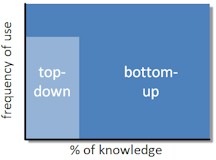![]() Throughout 2011 we will be publishing extracts from The New Learning Architect. We move on to the seventh part of chapter 4:
Throughout 2011 we will be publishing extracts from The New Learning Architect. We move on to the seventh part of chapter 4:
Bottom-up learning is managed by employees themselves. Why? Because it is in their interests to gain whatever knowledge and skills they need to perform effectively. A bottom-up approach is needed to address the 80% of learning that is needed 20% of the time. It most needs to be encouraged in those organisations in which there is constant change and fluidity in tasks and goals.

Bottom-up learning is cheaper, more responsive, less controlling, less patronising and altogether more in tune with the times. But it is also less certain, less measurable and less suited to dependent learners who don’t know what they don’t know.
For bottom-up learning to thrive, employees need the motive, the means and the opportunity (just like the perps in the crime novels). They will only have the motive if they are rewarded for effective performance. They will only have the means if employers help them to develop the metacognitive skills they need to learn independently and provide, where appropriate, the right collaborative software tools. They will only have the opportunity if employers are able to foster a culture which encourages self-initiative and does not penalise mistakes.
L&d professionals could do worse in future than to regard bottom-up learning as the default solution, the one they choose routinely except where it is obviously unsuitable. For too long, employees have been spoon-fed their education and their training, and have failed to develop as independent learners to the extent that perhaps they should have done. Those entering the workforce in 2010 have overcome these barriers and have higher expectations. Provide them with the motive, the means and the opportunities and their capabilities are likely to astound you.
Coming next in chapter 4: The model in action
Return to Chapter 1 Chapter 2 Chapter 3
Obtain your copy of The New Learning Architect
Skip to content
